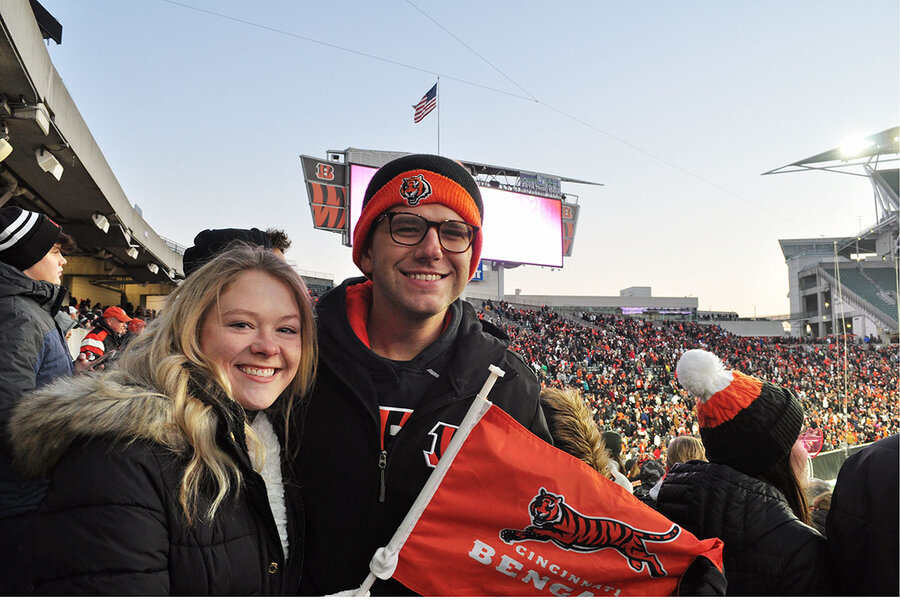Super Bowl glow: A Cincinnati native soaks up the city’s excitement
Loading...
| Cincinnati
Before this season, the Cincinnati Bengals football team hadn’t won a playoff game since the Soviet Union was a world power – meaning a large chunk of millennials and all of Generation Z had never witnessed a postseason victory.
Now, though, not only has our underdog team notched a Super Bowl bid, but the city – often considered a flyover by outsiders, even though it’s actually full of hidden gems and civic pride – is finally getting its due.
Why We Wrote This
The Bengals’ transformation from longtime NFL losers to possible Super Bowl champions is reviving the soul of their city, as Cincinnati sees itself in a new light.
“For the city to be on a national stage right now is big,” says Ashley Palmer at a recent citywide pep rally.
“It’s very electric – very,” adds her mother, Denise Baker, referring to the city’s atmosphere.
“[Cincinnati is] a classic midsize city battling against these juggernauts in the NFL,” my friend Toby says. “To see them finally have to talk about us, one, because we’re winning games and we’re in the Super Bowl, is great. But [two], it’s only going to be great for the city.”
Back at the rally, two fans dressed in Bigfoot suits hold up a sign that reads, “Believe.”
After all these years, I just might.
As the sun hovered over a warm Los Angeles afternoon on Monday, it was setting in Cincinnati, temperatures heading toward the 20s. Undeterred by the midwinter chill, Bengals fans poured into Paul Brown Stadium downtown for a citywide pep rally, chanting, as ever, “Who dey, Who dey, Who dey think gonna beat them Bengals?”
For decades, the realistic answer has been, “Well, anybody and everybody.”
But as the LA Rams and Cincinnati Bengals prepare for this weekend’s Super Bowl, the Bengals are perhaps one of the most transformed teams in the National Football League. Also transformed is the entire city, swept up in a frenzy to rally behind a team that is finally good. The underdog team and its under-the-radar city are finally getting the national attention they’ve long deserved, fans and residents say.
Why We Wrote This
The Bengals’ transformation from longtime NFL losers to possible Super Bowl champions is reviving the soul of their city, as Cincinnati sees itself in a new light.
The Monitor doesn’t often cover sports. But since being a Cincinnati fan is – for a brief moment, at least – no longer a Sisyphean task, I went back to my hometown ahead of the Super Bowl to get a glimpse of the magic.
“For the city to be on a national stage right now is big,” Ashley Palmer, one of the rally attendees, tells me as we bundle up against the riverfront chill. This moment is also, as her mother, Denise Baker, points out, the first time in years she’s been able to properly talk trash to friends and family who support other teams.
“It’s very electric – very,” Ms. Baker says of the city’s atmosphere. “Every place you go – orange and black, orange and black.” The neighboring town of Cheviot has temporarily renamed a handful of streets after Bengals players. Even out by my parents’ house in the suburbs, vendors are selling jerseys on a busy street corner.
Before this season, the Bengals hadn’t won a playoff game since the Soviet Union was a world power – meaning a large chunk of millennials and all of Generation Z had never witnessed a postseason victory. Anyone old enough to remember the Bengals’ Super Bowl appearances in the ’80s (both losses, of course) has spent the last few decades in the wilderness, their home team reduced to the butt of NFL jokes.
“We’ve just been waiting on this – and we deserve it,” says Chanel Bassette, who was only 5 when the Bengals last won a postseason game – too young, she says, to remember. “We all want this.”
My friend Toby Bolte, a lifelong Bengals fan, would agree. “I pay a lot of money for my season tickets, to watch a lot of bad football,” he says.
Two wins in 2019; a whopping four wins in 2020. The Bengals were being, well, the Bengals. Ms. Baker’s hopes heading into this season were for a measly five wins – anything that was an improvement over 2020. It all makes this year’s Super Bowl run even more unbelievable, more exciting.
My favorite Bengals memory is from 2014. The Bengals, with a home playoff game, were facing a television blackout due to low ticket sales. After all, what fan would want to attend a game their team was sure to lose? The team rallied its corporate sponsors to buy out the remaining tickets so the game would be broadcast. But the skeptics were right: The Bengals botched their third playoff game in a row. At least fans were able to watch the disaster unfold from the comfort of their living room.
To me, though, fans refusing to buy enough tickets felt like a rebuke, a collective strike against years of frustration. But maybe Bengals fans are just brutally, refreshingly honest. There was no point in buying a playoff game ticket, even for a game right down the street, and they knew it.
Now, though, not only has our underdog team notched a Super Bowl bid, but the city – often considered a flyover by outsiders even though it’s actually full of hidden gems and civic pride – is finally getting its due.
“It’s a classic midsize city battling against these juggernauts in the NFL,” says my friend Toby. “We always say they don’t talk about us on TV. ... To see them finally have to talk about us, one, because we’re winning games and we’re in the Super Bowl, is great. But [two], it’s only going to be great for the city.”
Amid the sense of shock and swelling excitement, it’s clear that you don’t stay a Bengals fan – or player – over all these years without developing a sense of humor.
Defensive end Sam Hubbard dedicated the team’s Super Bowl run to Harambe, a gorilla in the Cincinnati Zoo that rose to viral internet fame after his untimely death in 2016. Earlier in the season, quarterback Joe Burrow quipped that the team was able to avoid COVID-19 outbreaks because “there’s not a ton to do in Cincinnati.” (In response, Chad Johnson, a former wide receiver, offered a robust defense of the city, citing a Starbucks downtown and a McDonald’s across the river in Kentucky.)
At the rally, two fans are dressed in Bigfoot suits. Or maybe it’s two actual Bigfoots – Bigfeet? – in the flesh. For the past three decades, that sight would have been more likely than a Bengals Super Bowl appearance. They hold up a sign that reads, “Believe.”
After all these years, I just might.









